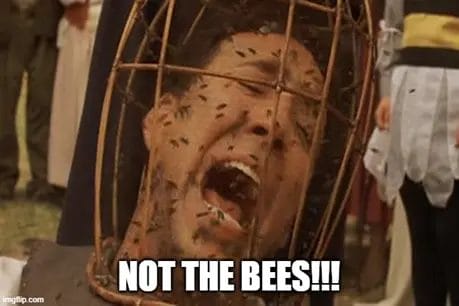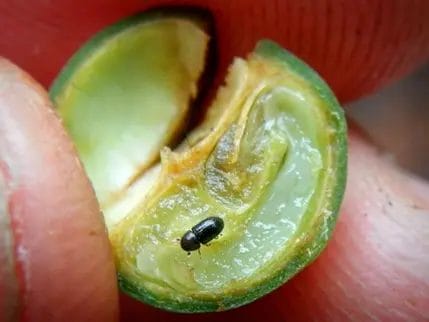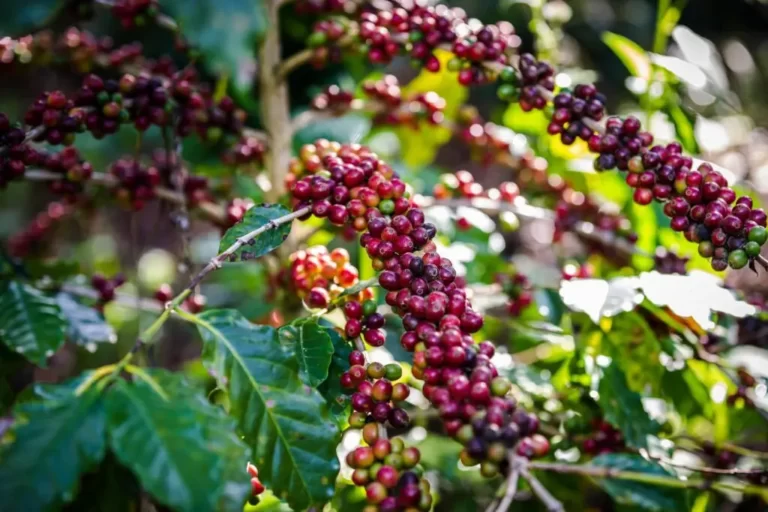By now, we all know that coffee beans contain caffeine, granting us the delicious, addictive morning refreshment that is coffee. But have you ever taken a moment to stop and think, “Why do coffee plants produce caffeine?”
If that question has ever crossed your mind, today is the day you get your answer. Because today, we are discussing why coffee plants have caffeine in them.
Friendly reminder that the article gets very dull and sciencey very fast, so bear with us. Why not grab a fresh cup while you read?
How Coffee Trees Produce Caffeine
Put on your reading glasses because this is the science part of the content.
Coffee plants start creating caffeine from a compound called “Xanthosine.” A total tongue twister, I know.

The xanthosine uses additional enzymes that are part of the methyltransferase enzyme. These enzymes are found in all sorts of plants, not just the coffee ones.
Caffeine came as a result of mutation of the N-methyltransferase. These mutated enzymes changed their behavior and interaction with other compounds present in a tree, producing coffee.
This mutation came from the survival needs of coffee plants from other insects. But this is not the first time a chemical produced inside a tree has proved helpful to humans.
Another example of this is aspirin, based on Salicylic acid found in willow trees.
Primary Reasons Why Coffee Has Caffeine
So far, we know that coffee plants have evolved in a way that they start producing caffeine. And the primary reason for that is to survive. So we do have things in common with coffee plants: both need caffeine to survive.
Something you should know, coffee plants aren’t the only ones that produce caffeine. Caffeine falls under the “alkaloid” category and is found in 60 different species of plants, one of which is the Coffea gene family, where coffee trees come from.
And here’s why coffee trees need caffeine to survive.
For Protection From Insects
The caffeine in coffee plants runs through the entire plant. This caffeine gets stored in the stem, leaves, flowers, coffee, fruit, and even in the seeds, we produce coffee. We choose the beans because coffee beans have the highest concentration of coffee in them.
Though we love caffeine, it’s toxic and bitter for the insects that try to ingest it. And for them, it can be fatal when they consume caffeine in a larger dose than their size.
When an insect consumes caffeine, it causes their nervous system to stop producing the enzymes they need to survive. Therefore, if an insect consumes a hefty dose of caffeine, it can cause paralysis and even death.
For Taking Out The Competition
Another use of caffeine in coffee plants is establishing superiority among other competing plants.
Coffee leaves and cherries contaminate the ground with caffeine when they die and fall to the ground, so other plants can not grow.
Caffeine infused by the leftovers in the ground inhibits the growth of other seeds, which gives coffee seeds and plants a competitive advantage. Meaning, coffee plants eliminate their competitors in their way.

For Attracting Pollinators
This is a weird one, considering that higher concentrations of caffeine are bitter and toxic for insects. You might think it’s not a very smart thing to do to use a killer chemical to attract insects to pollinate your plant, as it has a chance to kill the very insect you rely on for pollination.
But it works out in the end for both coffee trees and the bees that do the pollination. And it’s due to the reward system that caffeine activates in the brain of living creatures. But it still poses a question about the safety of the honey bees.

Honeybees have a natural affinity for detecting and avoiding toxins while pollinating, so I assure you, they’re completely safe.
Dr. Geraldine Wright from the Newcastle University of UK formed a team to research why coffee plants store caffeine in their flowers.
They found out that honey bees remember the scent of caffeine over a long-term memory, and they keep pollinating the flowers in hopes of the reward that is the caffeine, even at the lowest dose of introduction to the caffeine.
In nature, the honeybees keep going back to the coffee flowers to pollinate them to receive caffeine from the coffee flowers. Honeybees learn to associate the coffee flower scent with food and keep going back to those flowers for caffeine, effectively increasing the pollination rate.
Summary: coffee plants use caffeine in the coffee flowers to manipulate honeybees into pollinating them.
Having fun Nomies? Check out our piece on best tips for French press users.
Coffeeberry Borer Beetle
So, do you think the coffee plants are entirely safe from all harm? You would be wrong. There’s an insect that can bypass caffeine protection in coffee trees and can harm the tree and its products. Let’s get to know them.

The coffee borer beetle (Hypothenemus hampei) is the only creature in existence that feeds solely on coffee beans and survives. Their coffee eating habits give the palm civets a run for their money.
Origin
The coffee borer beetle is native to Africa, but due to an accidental introduction to the rest of the world, this force of nature can be found in all coffee-producing countries around the globe.
How It Operates
These insects reside in the coffee cherry while feeding on the coffee beans.
After boring a hole into the coffee cherries, the female insects lay their eggs in the coffee beans. The larvae consume the beans when they hatch since they contain the highest caffeine concentration in the entire plant.
And I wasn’t kidding when I said that their caffeine habits outperform any living creature on earth. These beetles can consume caffeine equivalent to 500 espressos. Such high doses of caffeine can be fatal to a human.

The secret lies within the belly of the beast. No, seriously, their digestive system breaks down and destroys the toxin that is caffeine.
Despite the borer beetle’s immunity to caffeine, farmers worldwide have slowly improved their strategies to fight this force of nature.
Prevention Of A Coffee Borer Beetle Attack
The primary step to stopping an infestation in plants is identifying the ground zero of said infection. Skilled coffee farmers always have a viable strategy for insect pest control.
When the infested crops are found, workers present in the field need to separate all the infected coffee cherries right away and use pesticides on the rest of the plants.
Coffee borer beetles are weak to antibiotics, as it destroys the secret fancy chemical in their stomach that destroys caffeine. So using antibiotics as a pest repellant for the coffee borer beetles is a viable method.
There’s another DIY technique that farmers use to battle borer beetles. It’s a trap painted red like a coffee fruit and filled with a combination of alcohol and coffee grounds.
The borer beetles get tricked by the visuals and the floral scent and dive right into the bottles for a feast. But instead of being able to feast on coffee, they end up drowning in the alcohol.

Factors That Affect Caffeine Amount In Coffee Beans
There are quite a few factors that affect the levels of caffeine in coffee plants. Here we discuss the most vital ones, aside from the obvious one that is genetics.
Bean Type
Caffeine levels in coffee plants vary by their species. But we already know by now that over 98% of the coffee comes from 2 major varieties.
Coffea Arabica, AKA Arabica, is the superior coffee bean type of the two, covering 60-70% of the worldwide coffee production. Though it is the most delicious coffee by taste, Arabica plants contain less caffeine content than the next type.
The next type in question is Coffea Canephora, Also known as Robusta. The lesser demand for this coffee comes from its bitterness from the excessive presence of caffeine content in the Robusta beans. Robusta supplies the remaining 30-40% of coffee needs.
Altitude
In a previous section, we talked about how caffeine works as a natural pesticide for the plants to survive, right? So it affects the survivability of the coffee plants at different altitudes.
Since Robusta has double the caffeine content in them than Arabica beans, robusta plants can survive at lower altitudes, even when faced with more insects.
Usually, robusta plants are grown at elevations between 200-600 meters (650-2000ft). But, they can even be grown at sea level.
Since Arabica beans have less caffeine, they need to be grown at higher elevations. At high altitudes, most insects don’t survive and reduce the risk of an infestation.
Recommended altitude for Arabica growth is between 1000-2000 meters from sea level (3250-6500 ft).
In short: coffee plants produced in higher altitudes provide lower amounts of caffeine. Whereas coffee grown in a lower altitude has more caffeine content as a natural prevention for insect attacks.
Shade
This may sound a bit odd, but yes, how much sunlight or shade a particular plant is getting affects the levels of caffeine it will produce.
On higher altitudes, the beans are exposed to more sunlight, and of course, have less shade. This causes the beans to grow heavier in density and have lower caffeine.
Robusta coffee plants are cultivated at a lower altitude, where farmers can provide enough shade for them to prevent excess sunlight from affecting the enzymes of the beans, and it increases the caffeine content in the coffees. This is another reason Robusta beans have more caffeine than Arabica beans.
Having fun to read about why coffee plants produce caffeine?
You’ll love check our piece on tips for picking espresso coffee beans.
How Caffeine Affects Humans
I could summarize this entire section by saying: “Caffeine affects us like magic which gives us the motivation to get up from our bed and get stuff done.”

Caffeine works as a stimulant for our central nervous system, affecting us in more than one way.
The safe limit of daily caffeine consumption is 400mg of caffeine per day for a healthy adult, which amounts to up to around six cups of espresso shots.
Now, take a moment to reflect on the coffee borer beetle, which can take up to 500 espresso shots worth of coffee per day and remain unfazed, which is impressive yet terrifying.
Daily caffeine consumption hits the part of your brain that increases your alertness, which is why you stay awake, and in some cases, you feel more concentrated than usual.
But when you continuously maintain your caffeine intake, your body builds up a tolerance to the effects of caffeine. So to get the same kick out of coffee that you used to before, you then start to consume even more coffee.
If you don’t want to build a tolerance for the stimulating effects and keep enjoying the benefits, it’s best to drink coffee only when you need it the most.
Consumption of large amounts of caffeine has more downsides than just the addicting part. When you face withdrawal, it will cause you several physical issues, which includes:
- Serious headaches
- Panicking anxiety
- Severe irritability
- Constant drowsiness
- Sudden tremors (such as shaky hands/ body etc.)
The only short-term effect that is worrying about caffeine is that it increases your blood pressure for a while. But this effect doesn’t last long. Coffee has several long-lasting benefits going on for you, such as the prevention of Alzheimer’s, cancer, and type 2 diabetes.
However, you need to exercise caution if you have an irregular heart rhythm or suffer from anxiety or hypertension. In cases like these, a nerve stimulant may not be optimal for you. Consult a doctor to determine if coffee is safe for you or not or for a necessary prescription to reduce caffeine content.
Caffeine produces acid in your stomach, which can also adversely affect you if you have a sensitive stomach or high acidity issue. In this case, switch to low acidity coffee, or decaf, or worst-case scenario, lay off of coffee entirely.

Another case where caffeine shouldn’t be taken without supervision is during pregnancy. The reasons being:
- Coffee increases the heart rate of the baby in you
- Coffee can cause increased metabolism in the child
- Unsupervised caffeine consumption during pregnancy can slow down fetal growth
- Overconsumption of caffeine during pregnancy can cause miscarriage
The safe limit for a pregnant person is 100-200 milligrams of caffeine per day.
Had fun reading why coffee plants produce caffeine?
You’ll love to read our piece on tips to avoid caffeine crash.
Bottom Line
Though natural caffeine is an insect pest control deployed by the mighty coffee plants, it’s not harmful to us. Not if we stay within the safe consumption limit anyway.
Stay safe, and keep drinking your favorite coffee! Cheers!
FAQs
Coffee plants produce caffeine as a survival tool, and this caffeine runs through the entire coffee plant. The seeds contain the highest amount of caffeine content, which is what coffee is made from
Caffeine works as a natural pesticide for insects due to its toxic and bitter characteristics. Coffee plants produce caffeine to ensure their survival. Coffee plants also provide an increased pollination rate by storing caffeine in coffee flowers and manipulating the honeybees with it.
Coffee provides us several health benefits by improving our resistance towards Alzheimer’s, cancer, diabetes. Coffee also increases our alertness and concentration.
The safe limit for a pregnant person to intake caffeine is 100-200mg per day.
The coffee borer beetle feeds on the caffeine of the coffee beans inside the cherry to survive. Not just the beetle, the larvae hatched from the beetle’s eggs also feed on the coffee beans for survival.

